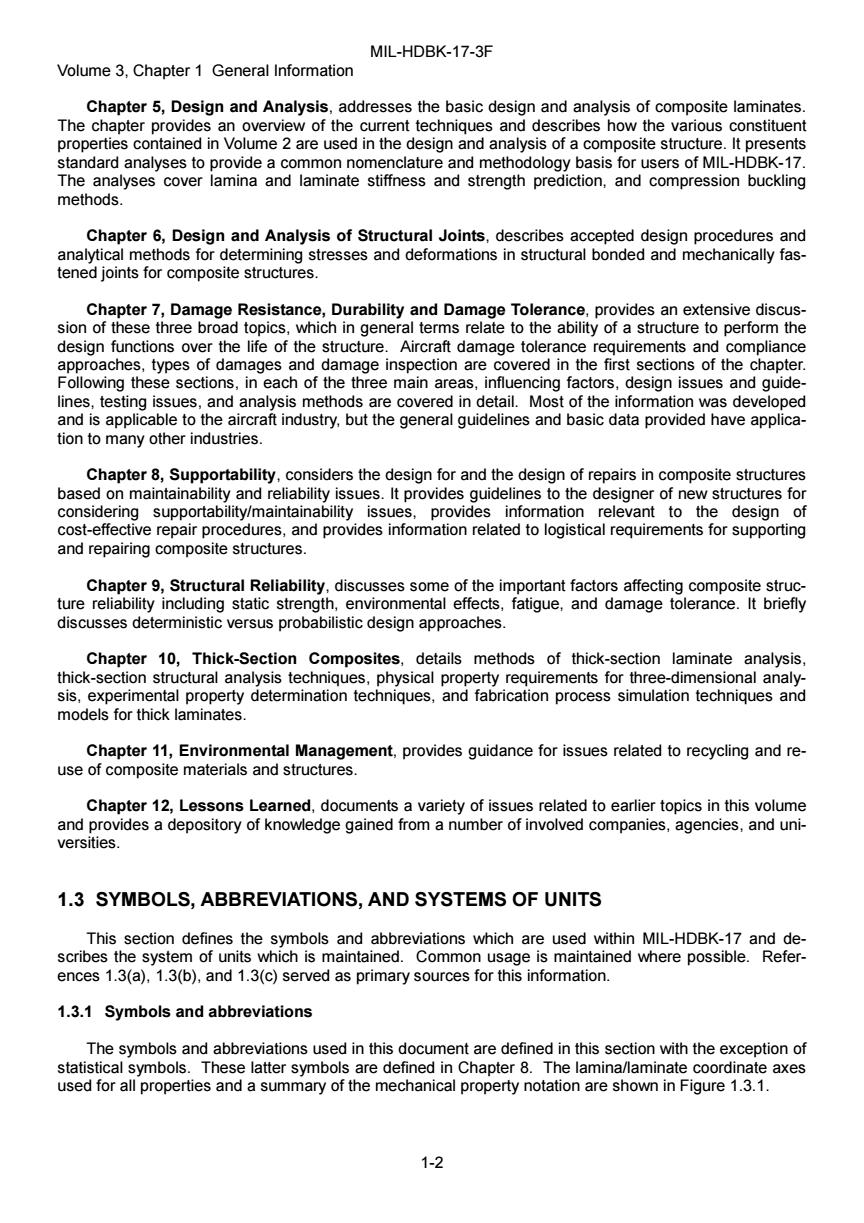正在加载图片...

MIL-HDBK-17-3F Volume 3,Chapter 1 General Information Chapter 5,Design and Analysis,addresses the basic design and analysis of composite laminates. The chapter provides an overview of the current techniques and describes how the various constituent properties contained in Volume 2 are used in the design and analysis of a composite structure.It presents standard analyses to provide a common nomenclature and methodology basis for users of MIL-HDBK-17. The analyses cover lamina and laminate stiffness and strength prediction,and compression buckling methods. Chapter 6,Design and Analysis of Structural Joints,describes accepted design procedures and analytical methods for determining stresses and deformations in structural bonded and mechanically fas- tened joints for composite structures. Chapter 7,Damage Resistance,Durability and Damage Tolerance,provides an extensive discus- sion of these three broad topics,which in general terms relate to the ability of a structure to perform the design functions over the life of the structure.Aircraft damage tolerance requirements and compliance approaches,types of damages and damage inspection are covered in the first sections of the chapter. Following these sections,in each of the three main areas,influencing factors,design issues and guide- lines,testing issues,and analysis methods are covered in detail.Most of the information was developed and is applicable to the aircraft industry,but the general guidelines and basic data provided have applica- tion to many other industries. Chapter 8,Supportability,considers the design for and the design of repairs in composite structures based on maintainability and reliability issues.It provides guidelines to the designer of new structures for considering supportability/maintainability issues,provides information relevant to the design of cost-effective repair procedures,and provides information related to logistical requirements for supporting and repairing composite structures. Chapter 9,Structural Reliability,discusses some of the important factors affecting composite struc- ture reliability including static strength,environmental effects,fatigue,and damage tolerance.It briefly discusses deterministic versus probabilistic design approaches. Chapter 10,Thick-Section Composites,details methods of thick-section laminate analysis, thick-section structural analysis techniques,physical property requirements for three-dimensional analy- sis,experimental property determination techniques,and fabrication process simulation techniques and models for thick laminates Chapter 11,Environmental Management,provides guidance for issues related to recycling and re- use of composite materials and structures. Chapter 12,Lessons Learned,documents a variety of issues related to earlier topics in this volume and provides a depository of knowledge gained from a number of involved companies,agencies,and uni- versities 1.3 SYMBOLS,ABBREVIATIONS,AND SYSTEMS OF UNITS This section defines the symbols and abbreviations which are used within MIL-HDBK-17 and de- scribes the system of units which is maintained.Common usage is maintained where possible.Refer- ences 1.3(a),1.3(b),and 1.3(c)served as primary sources for this information. 1.3.1 Symbols and abbreviations The symbols and abbreviations used in this document are defined in this section with the exception of statistical symbols.These latter symbols are defined in Chapter 8.The lamina/laminate coordinate axes used for all properties and a summary of the mechanical property notation are shown in Figure 1.3.1. 1-2MIL-HDBK-17-3F Volume 3, Chapter 1 General Information 1-2 Chapter 5, Design and Analysis, addresses the basic design and analysis of composite laminates. The chapter provides an overview of the current techniques and describes how the various constituent properties contained in Volume 2 are used in the design and analysis of a composite structure. It presents standard analyses to provide a common nomenclature and methodology basis for users of MIL-HDBK-17. The analyses cover lamina and laminate stiffness and strength prediction, and compression buckling methods. Chapter 6, Design and Analysis of Structural Joints, describes accepted design procedures and analytical methods for determining stresses and deformations in structural bonded and mechanically fastened joints for composite structures. Chapter 7, Damage Resistance, Durability and Damage Tolerance, provides an extensive discussion of these three broad topics, which in general terms relate to the ability of a structure to perform the design functions over the life of the structure. Aircraft damage tolerance requirements and compliance approaches, types of damages and damage inspection are covered in the first sections of the chapter. Following these sections, in each of the three main areas, influencing factors, design issues and guidelines, testing issues, and analysis methods are covered in detail. Most of the information was developed and is applicable to the aircraft industry, but the general guidelines and basic data provided have application to many other industries. Chapter 8, Supportability, considers the design for and the design of repairs in composite structures based on maintainability and reliability issues. It provides guidelines to the designer of new structures for considering supportability/maintainability issues, provides information relevant to the design of cost-effective repair procedures, and provides information related to logistical requirements for supporting and repairing composite structures. Chapter 9, Structural Reliability, discusses some of the important factors affecting composite structure reliability including static strength, environmental effects, fatigue, and damage tolerance. It briefly discusses deterministic versus probabilistic design approaches. Chapter 10, Thick-Section Composites, details methods of thick-section laminate analysis, thick-section structural analysis techniques, physical property requirements for three-dimensional analysis, experimental property determination techniques, and fabrication process simulation techniques and models for thick laminates. Chapter 11, Environmental Management, provides guidance for issues related to recycling and reuse of composite materials and structures. Chapter 12, Lessons Learned, documents a variety of issues related to earlier topics in this volume and provides a depository of knowledge gained from a number of involved companies, agencies, and universities. 1.3 SYMBOLS, ABBREVIATIONS, AND SYSTEMS OF UNITS This section defines the symbols and abbreviations which are used within MIL-HDBK-17 and describes the system of units which is maintained. Common usage is maintained where possible. References 1.3(a), 1.3(b), and 1.3(c) served as primary sources for this information. 1.3.1 Symbols and abbreviations The symbols and abbreviations used in this document are defined in this section with the exception of statistical symbols. These latter symbols are defined in Chapter 8. The lamina/laminate coordinate axes used for all properties and a summary of the mechanical property notation are shown in Figure 1.3.1